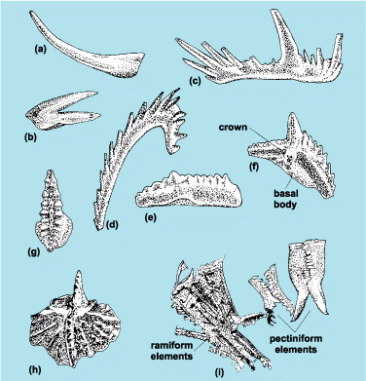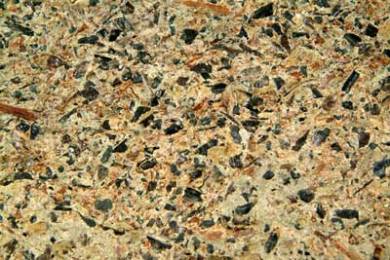Hello Luke here, here it is then my first post on fish related to my research, sorry it’s so late folks but it’s been quite hectic. But before I introduce the cast of characters I will just mention what my PhD is on. I am looking at the Downton bone bed from the welsh borders; some of you may be wondering “Downton bone bed? Well I have heard or the very famous Ludlow bone bed”. This is kind of the point of my research, when you look at the Ludlow bone (fig.1) you can see this grey lithology and all those black grains…their fossils and in particular fish fragments. This is also true of the Downton bone bed however if you were to see it you would not clearly see the fossils, this is because all the fossil grains are of a similar colour to the lithology (a tan/brown colour) and this is why it has been missed for full investigation for the last 150+ years. So the next few sections for you delectation are some brief summaries of the types of fossil fish that I will come across, of course one the most exciting aspects of my PhD is the potential of finding new things, now this does not necessarily mean new species but possibly fish that are not known from this part of the world or at this time or who knows what. So without further ado here are the cast of characters I will become familiar with over the next possible 6 years and hopefully you guys will learn to love them, these odd bunch of early fish.
Condonts
So these little jawless beauties appear in the Cambrian and make it all the way to the end Triassic! That is very impressive when you consider a lot of these fish don’t make it past the P/T mass extinction let alone animals getting past the Devonian. While on the subject of “animals” let’s clear things up about condonts and conodont animals, now condonts have been know about since 1856 when Christian Pander a Latvian embryologist and palaeontologist first identified them but, they were not the whole animal. They are calcium phosphate (or to be all fancy like calcium carbonate fluroapatite) microfossils known as conodont elements (fig.2)

Figure 2. Conodont elements: (a, b) coniform elements, (c, d) ramiform elements, (e, f) pectiniform blade elements, (g, h) pectiniform platform elements, (i) bedding-plane assemblage.
which would have been found in the mouth of the animal (fig.3) Now these elements can be categorised by shape into different types protoconodonts, paraconodonts and euconodonts and due to taxa like Ozarkodina whose apparatus has been found complete and articulated we know how they looked in the living animal (fig.4).
So what about the living animals well the conodont animal or as some

Figure 3. (A) Dorsal view of the reconstructed, closed apparatus of Novispathodus.(B) Orientation of the apparatus within the conodont’s head.
researchers are suggesting they should be called Conodontophora (conodont bearers), either works for me. These were eel like fish (fig.5) ranging from a less than a centimetre to those gigantic Ordovician monsters of the Soom shale which were 10’s of centimetres. Now it is at this point I should explain some of the many controversies with conodonts, so first off; what are these chaps (and chapettes) eating, well the main idea is that these were filter feeders using that complex apparatus in the mouth to filter out plankton from the water column. However in more recent years researchers have found that the elements have microwear patterns and this tells us that these guys are grasping prey so they are more likely swift little hunters.

Figure 4 (a) natural assemblage of conodonts from the Carboniferous of Illinois (×24); and (b) the conodont animal from the Carboniferous Granton Shrimp Bed, Edinburgh, Scotland, with the head at lefthand end (×1.5).
Other blog posts in the works for these critters are; Conodonts: are they vertebrates? (yes and here’s why) and were conodonts venomous?
Thelodonts
Ah thelodonts or to translate their name ‘nipple tooth’, these jawless fish (agnatha) ranging from a few centimetres to meter in length and make up the bulk of the bone bed fauna so far seen. Now I apologise if I wax lyrical about these guys but in terms of my project I have come across hundreds of these guys but like 4 conodont elements so you can understand if these get a tad more press but worry not fans of conodonts they will get their own post.
So let’s get into them, they appear in the Middle or Late Ordovician and sadly bit farewell and join the choir invisible in the Late Devonian. We find their fossils can be found all over the world and we can find them as complete articulated specimens but the majority of their fossils (and certainly this is the case with my material) they are found as isolated micro fossils (fig. 6). I should at this point explain what thelodonts are; they are fish with an endoskeleton of cartilage and then there skin is covered in dermal denticles (fig.7) in a slightly analogous way with sharks. The denticles, as the dent part of the word suggests are related to teeth…that is for want of a better word they are teeth in the skin (hence the dermal bit). In the fossil record they usually “rock” (no pun intended) up as isolated denticles in sediment most famously in the Late Silurian bone beds but occasionally as entire articulated specimens found in places like Canada, Scotland and Scandinavia with all their denticles in place. While on the subject of places we find their remains add to the list Russia, Australia, South East Asia, Europe and finally North and South America. They are a monophyletic group although one group the Furcacaudiformes from Canada are morphologically very different and there is debate on their position in thelodonti and represent a new order of thelodonts (Märss, 2006a).
Overall thelodont affinities remain somewhat unclear, it has been suggested that they are the sister taxa to the osteostracans and could also be close to chondrichthyes but the way thelodonts have their micromeric squamations (scales) is different from both. Ultimately when it comes to where these fish fit one must remember there we are talking about a group of animals mostly known from there isolated dermal denticles in fact in most decent phylogenetic analyses only contains24 to 25 taxa because that’s how many we have articulated. Now that’s not to say that that makes it invalid I am unsure how many characters were generated but 24 taxa is quite a small selection but does once again highlight the challenges one faces when dealing with the fossil record.
On a final foot note for now diet wise these chaps are probably eating plankton, algae and rubbish (well deposit and suspension feeding on sediment) in fact the Furcacaudiformes with their deep bodies and large eyes were suggested to be predators. Right well not top of the line predators but still taking on small prey items however it is more likely the large eyes were used to help select only the tastiest bits of detritus….also helps in spotting predators, like giant sea scorpions.
Acanthodians
The final group of fish that I will be looking at and discussing here are the “spiny sharks” or acanthodians (fig. 8) named in 1844 by Agassiz (for more information about Agassiz’s life and work click here). This group gets its name from the Greek word akanthos which means spine and it’s well placed as they are the only fish that processed spines on all their fins. They appeared in the Silurian which is handy for me and disappeared when coprolite hit the fan with end Permian extinction. However one of the most notably features of the acanthodians are jaws…yes these are some of the first jawed vertebrates but at the time of my research (roughly 420 ma) they are not the dominant fish fauna it’s still the agnathans. There found in the fossil record like thelodonts both as, in my case isolated fragments of denticles or as articulated specimens and they are found in all corners of the globe. In terms of there relationships with other early fish we rule out early sharks (although the spiny sharks name came from morphological similarities) placoderms and early actinopterygians, but of the jawless ancestors only thelodonts come close to a similar micromeric squamation but it is unlikely the two are that closely related. It now seems that they share a lot of specialized characters with osteichthyans compared to other groups, some of the characters are: similar shaped brain case, nature of the gill filaments (hemibranchs) along the gill arch and the presence of brachiostegal rays. Although (Davis et al 2012), found that they are somewhat split between the osteichthyans and the chondrichthyans, so once again this shows that with dealing with fish this far back getting a complete resolution of their origins can be difficult.
There are three subgroups of acanthodians the first is the Climatiiformies which were I guess the “standard” acanthodian although were more heavily armoured than the other two. The next it is the Ishnacanthiformes which had robust jaws and big teeth and assumed to be the predators of the group and finally the Acanthodiformes which were the most successful of the groups and despite developing jaws became filter feeders (turns out have jaws is not just handy for grabbing food items). The final bit of classification is the scale morphology there being two types, one is the Acathodes type which is a crown made of true dentine and a thick acellular bone base and Nostolepis type that has a dentine crown penetrated by vascular canals and a base of cellular bone.
Others
Now there have also been chondrichthyan scales found in bone beds of this age in the welsh borders but apart from saying “there are sharky things in them there hills” I can’t expand really, I also may come across material from other types of agnathans and as soon as the thesis or paper is accepted I will be blogging about it, I also plan to do more in depth posts on these groups but all in good time.
So yes there we are that’s the sort of fish I will be working on hopefully Chris will tell you about his fish soon so until next time (which will be a special post) take care.
References
Davis, S. P.; Finarelli, J. A.; Coates, M. I. 2012. “Acanthodes and shark-like conditions in the last common ancestor of modern gnathostomes”. Nature 486 (7402): 247.
Janvier. P, 1996. Early Vertebrates, Clarendon press. Oxford. Pp.393
Long. J.A, 2010. The rise of fishes: 500 million years of evolution, Johns Hopkins University Press. pp.304
Märss, T. Turner, S. & Karatajūtė-Talimaa, V. 2007. Handbook of paleoichthyology Volume 1B “Agnatha” II Thelodonti, pp.141.
Märss, T., 2006a. Exoskeleton ultrasculpture of the early agnathans and fishes. – Journal of vertebrate paleontology. 26(2), p.235-252.
All taken from Google images apart from figure 4 taken from http://www.blackwellpublishing.com/paleobiology/figure.asp?chap=16&fig=Fig16-5&img=c16f005.





